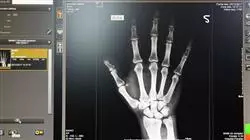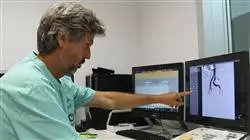University certificate
The world's largest faculty of medicine”
Introduction to the Program
Improve your knowledge of Clinical Imaging for Emergency and Critical Care through this program, where you will find the best teaching material with real clinical cases. Learn about the latest advances in the specialty to be able to provide excellent medical care"

In some medical activities, such as emergency and critical care, the interrelationship between the clinician and the imaging specialist is important.
In most hospitals, radiologists collaborate closely with emergency physicians and critical care staff, being in charge of sequencing, prioritization and administration of imaging techniques, but responding to their clinical needs.
Wherever a patient is and whatever their health problem, the result of this interrelation between specialists is impressive, since not only is the quality of the images obtained improved, but also morbidity and mortality are reduced.
Emergency and critical care clinicians and radiologists must know the indications and practical usefulness of imaging techniques, and know how to interpret the information derived from them.
This knowledge will have an impact on each of the six fundamental domains of the current concept of quality of care: patient safety, effectiveness, efficiency, equity, opportunity and humanization.
Patient safety, by reducing diagnostic errors and time-to-treatment intervals, and errors in therapeutic procedures.
Effectiveness and efficiency, by favorably modifying the "success at first attempt" in diagnoses and interventions, optimizing the cost/benefit ratio in decision making.
Equity, as they can be applied equitably in a short period of time to all patients in need.
Timeliness, for its ability to provide "here and now" the right answers to the questions required for better patient care.
Humanization, by facilitating the doctor-patient relationship with continuous care during travel to remote and unfamiliar places for the patient or during the intervention of specialists who are not usually involved in the patient's care.
Update your knowledge through this Master’s Degree in Clinical Imaging for Emergency and Critical Care”
This Masters Degree in Clinical Imaging for Emergency and Critical Care contains the most complete and up-to-date scientific program on the market. The most important features include:
- More than 75 clinical cases presented by experts in clinical imaging. The graphic, schematic, and practical contents with which they are created provide scientific and practical information on the disciplines that are essential for professional practice
- Diagnostic and therapeutic developments in assessment, diagnosis and intervention in Clinical Imaging for Emergency and Critical Care
- Practical exercises where the self-evaluation process can be carried out to improve learning
- Clinical iconography and diagnostic image tests
- An algorithm-based interactive learning system for decision-making in the clinical situations presented throughout the course
- Special emphasis on evidence-based medicine and clinical imaging research methodologies for emergency and critical care
- All of this will be complemented by theoretical lessons, questions to the expert, debate forums on controversial topics, and individual reflection assignments
- Content that is accessible from any fixed or portable device with an Internet connection
This Masters Degree may be the best investment you can make when selecting a refresher program, for two reasons: in addition to updating your knowledge in Clinical Imaging for Emergency and Critical Care, you will obtain a Master’s Degree from TECH Global University”
The teaching staff includes professionals from the field of Clinical Imaging for Emergency and Critical Care who bring their experience to this training program, as well as renowned specialists from leading scientific societies.
The multimedia content developed with the latest educational technology will provide the professional with situated and contextual learning, i.e., a simulated environment that will provide an immersive academic experience programmed to learn in real situations.
This program is designed around Problem-Based Learning, whereby the physician must try to solve the different professional practice situations that arise throughout the program. For this purpose, the physician will be assisted by an innovative interactive video system created by renowned and experienced experts in the field ofClinical Imaging for Emergency and Critical Care with extensive teaching experience.
Increase your decision-making confidence by updating your knowledge through this Masters Degree "

Make the most of this opportunity to learn about the latest advances in Clinical Imaging for Emergency and Critical Care and improve your patient care"
Why study at TECH?
TECH is the world’s largest online university. With an impressive catalog of more than 14,000 university programs available in 11 languages, it is positioned as a leader in employability, with a 99% job placement rate. In addition, it relies on an enormous faculty of more than 6,000 professors of the highest international renown.

Study at the world's largest online university and guarantee your professional success. The future starts at TECH”
The world’s best online university according to FORBES
The prestigious Forbes magazine, specialized in business and finance, has highlighted TECH as “the world's best online university” This is what they have recently stated in an article in their digital edition in which they echo the success story of this institution, “thanks to the academic offer it provides, the selection of its teaching staff, and an innovative learning method aimed at educating the professionals of the future”
A revolutionary study method, a cutting-edge faculty and a practical focus: the key to TECH's success.
The most complete study plans on the university scene
TECH offers the most complete study plans on the university scene, with syllabuses that cover fundamental concepts and, at the same time, the main scientific advances in their specific scientific areas. In addition, these programs are continuously being updated to guarantee students the academic vanguard and the most in-demand professional skills. In this way, the university's qualifications provide its graduates with a significant advantage to propel their careers to success.
TECH offers the most comprehensive and intensive study plans on the current university scene.
A world-class teaching staff
TECH's teaching staff is made up of more than 6,000 professors with the highest international recognition. Professors, researchers and top executives of multinational companies, including Isaiah Covington, performance coach of the Boston Celtics; Magda Romanska, principal investigator at Harvard MetaLAB; Ignacio Wistumba, chairman of the department of translational molecular pathology at MD Anderson Cancer Center; and D.W. Pine, creative director of TIME magazine, among others.
Internationally renowned experts, specialized in different branches of Health, Technology, Communication and Business, form part of the TECH faculty.
A unique learning method
TECH is the first university to use Relearning in all its programs. It is the best online learning methodology, accredited with international teaching quality certifications, provided by prestigious educational agencies. In addition, this disruptive educational model is complemented with the “Case Method”, thereby setting up a unique online teaching strategy. Innovative teaching resources are also implemented, including detailed videos, infographics and interactive summaries.
TECH combines Relearning and the Case Method in all its university programs to guarantee excellent theoretical and practical learning, studying whenever and wherever you want.
The world's largest online university
TECH is the world’s largest online university. We are the largest educational institution, with the best and widest online educational catalog, one hundred percent online and covering the vast majority of areas of knowledge. We offer a large selection of our own degrees and accredited online undergraduate and postgraduate degrees. In total, more than 14,000 university degrees, in eleven different languages, make us the largest educational largest in the world.
TECH has the world's most extensive catalog of academic and official programs, available in more than 11 languages.
Google Premier Partner
The American technology giant has awarded TECH the Google Google Premier Partner badge. This award, which is only available to 3% of the world's companies, highlights the efficient, flexible and tailored experience that this university provides to students. The recognition as a Google Premier Partner not only accredits the maximum rigor, performance and investment in TECH's digital infrastructures, but also places this university as one of the world's leading technology companies.
Google has positioned TECH in the top 3% of the world's most important technology companies by awarding it its Google Premier Partner badge.
The official online university of the NBA
TECH is the official online university of the NBA. Thanks to our agreement with the biggest league in basketball, we offer our students exclusive university programs, as well as a wide variety of educational resources focused on the business of the league and other areas of the sports industry. Each program is made up of a uniquely designed syllabus and features exceptional guest hosts: professionals with a distinguished sports background who will offer their expertise on the most relevant topics.
TECH has been selected by the NBA, the world's top basketball league, as its official online university.
The top-rated university by its students
Students have positioned TECH as the world's top-rated university on the main review websites, with a highest rating of 4.9 out of 5, obtained from more than 1,000 reviews. These results consolidate TECH as the benchmark university institution at an international level, reflecting the excellence and positive impact of its educational model.” reflecting the excellence and positive impact of its educational model.”
TECH is the world’s top-rated university by its students.
Leaders in employability
TECH has managed to become the leading university in employability. 99% of its students obtain jobs in the academic field they have studied, within one year of completing any of the university's programs. A similar number achieve immediate career enhancement. All this thanks to a study methodology that bases its effectiveness on the acquisition of practical skills, which are absolutely necessary for professional development.
99% of TECH graduates find a job within a year of completing their studies.
Master's Degree in Clinical Imaging for Emergency, Critical Care and Emergency Medicine
The extensive field of application of imaging techniques in modern emergency departments makes this practice an indispensable tool for professionals specialized in this field of care. Due to this situation, there is an increasing interest on the part of physicians specialized in emergencies, for the approach of academic updating programs that allow them to improve their practical knowledge in the application of imaging techniques. Understanding this fact and with the intention of offering training alternatives of the highest quality, at TECH Global University we have designed our Master's Degree program in Clinical Imaging for Emergencies, Emergencies and Critical Care. In this postgraduate program we will delve into the latest technological advances applied to digital angiography processes. In addition, the following topics will be updated: the identification of the different fields of application of magnetic resonance in the field of emergency, the practical management of Doppler ultrasound and bladder ultrasound in the detection of cases of acute renal failure.
Study an online Master's Degree in Clinical Imaging for Emergency, Critical Care and Emergency Medicine
The large number of contexts in which modern imaging techniques are developed imply, for their adequate performance, the presence of specialized professionals with a broad theoretical and practical knowledge and a high degree of preparation and expertise. In our Master's Degree program you will acquire the necessary skills and abilities for an adequate performance in the application of imaging techniques in emergency services. Likewise, in this postgraduate program you will deepen in the modernization of the following aspects: the possibilities present in the implementation of imaging techniques for the detection of cases of traumatic injuries of the central nervous system and the particularities to be considered in the development of a computed tomography process.







